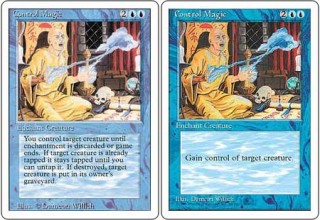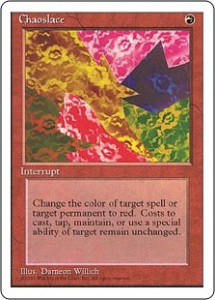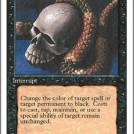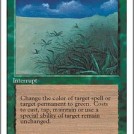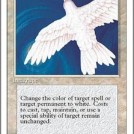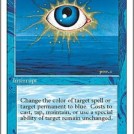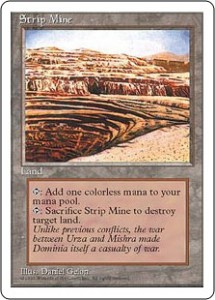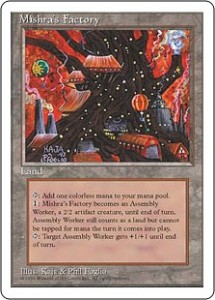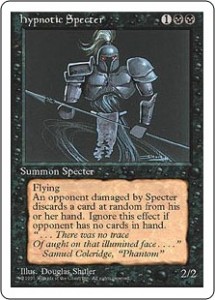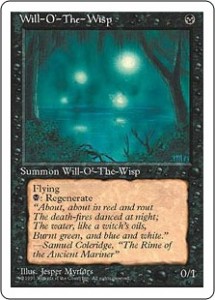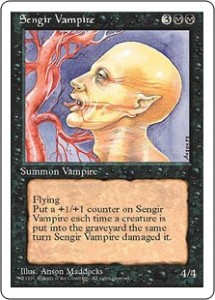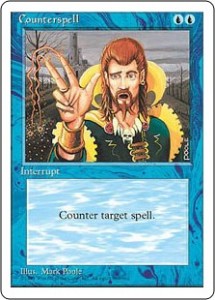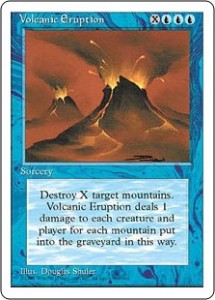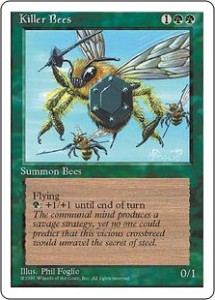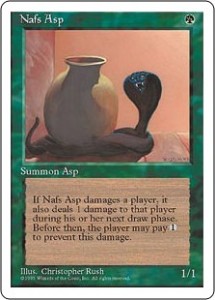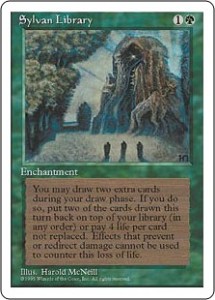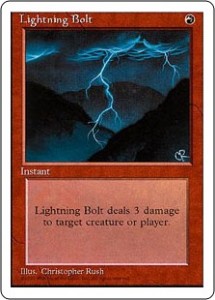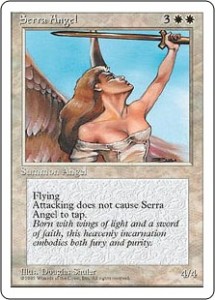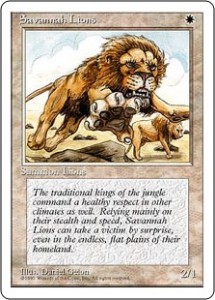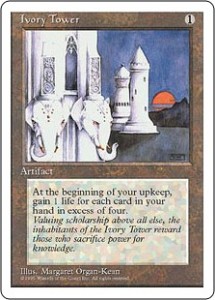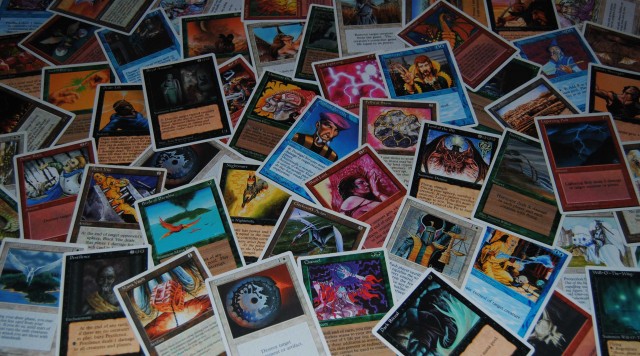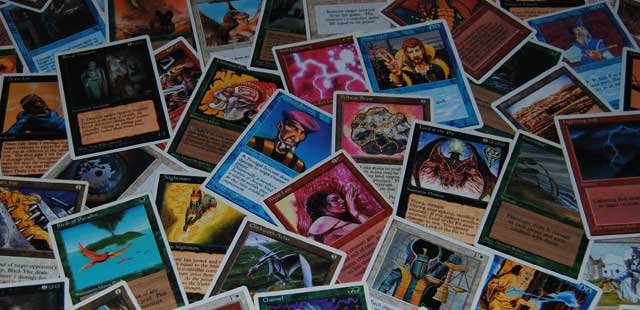
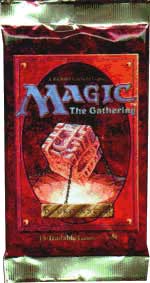
Fourth Edition Booster Pack
An Introduction to Fourth Edition
Released in April 1995, Fourth Edition was a changing of the the guard for base or core sets in Magic: the Gathering. It was comprised of 378 cards, 72 more than Revised Edition, but it wasn’t straight up addition. It was the addition of 120 cards from Antiquities (23 cards), Arabian Nights (10 cards), Legends (55 cards) and The Dark (32 cards), two cards that returned from the base set that were not printed in Revised and a subtraction of 50 cards from the Revised setlist.
The set was a compilation of 70 Artifacts, 58 Black cards, 58 Blue cards, 58 Green cards, 58 Red cards, 58 White cards and 18 Land cards. For rarity’s sake, it had 15 basic lands, 121 Commons, 121 Uncommons and 121 Rares. None of the remaining base set cards changed rarity in Fourth Edition, although a number of the cards added from Antiquities, Arabian Nights, Legends and The Dark had their rarity changed.
See the complete list of additions from Antiquities, Arabian Nights, Legends and The Dark.
Focusing on the positive additions to the set is one thing, but there were 50 cards removed from Revised to Fourth Edition which changed the game forever. Most basic and most missed were the Dual Lands. No more Bandlands, Bayou, Plateau, Savannah, Scrubland, Taiga, Tropical Island, Tundra, Underground Sea or Volcanic Island. But it wasn’t just the lands that got removed. Braingeyser, Clone, Copy Artifact, Demonic Hordes, Demonic Tutor, Fastbond, Fork, Juggernaut, Kird Ape, Living Wall, Nettling Imp, Regrowth, Resurrection, Rock Hydra, Serendib Efreet, Sol Ring, Vesuvan Doppleganger, Veteran Bodyguard and Wheel of Fortune, just to name a few of the cards players missed having available to them.
It wasn’t all about subtracting cards, Wizards of the Coast subtracted words as well. Animate Wall’s card text was edited from 21 words down to five, although it still did the same thing, Cockatrice from 24 down to 15, Control Magic from 35 down to 5, you get the idea. But it wasn’t just about subtracting text either, they did add some in places, specifically, “until end of turn” was a phrase added to cards to clear up confusion.
The TAP symbol was also changed. In 1994 when Fallen Empires was released it was an angled “T” in a grey circle. But in 1995 Fourth Edition TAP symbols had changed to an arrow in an angled rectangle in a grey circle.

Tap Symbol Change
Lastly, there was the art of Magic: the Gathering. Fourth Edition was the last bastion of card art remaining the same. All of the cards in Fourth Edition from Alpha, Beta, Unlimited, Revised, Antiquities, Arabian Nights, Legends and The Dark had retained their original artwork. This was to change soon. Chronicles, was a straight up reprint of select cards from various expansions, but with Ice Age and the arrival of Fifth Edition card artwork was to change.
This was a cosmic shift as up to Fourth Edition a Counterspell always looked one way, a Serra Angel, Giant Growth, Hurricane, etc, always looked the same. Fourth Edition was one of the last sets to include the most basic cards with their original artwork, and that goes for basic lands as well. Never again, would the original artwork of Forests, Islands, Mountains, Plains or Swamps look the same.
The “laces” were also to be banished from the game, so to speak, after Fourth. Chaoslace, Deathlace, Lifelace, Purelace and Thoughtlace all allowed you to change a spell or permanent to their respective color.
Although the ability to do so would remain thanks to some cards, the laces were removed from the core set, never to be printed again.
The Land of Fourth Edition: Two Welcome Additions from Antiquities and Oasis
Since, Fourth Edition is a core or base set it includes the five basic lands; Forests, Islands, Mountains, Plains and Swamps, but it’s the first core set not to include the ten Dual Lands. This doesn’t mean Fourth Edition doesn’t have some lands of substance. Included with all of the additions to the set were three lands from expansions; Mishra’s Factory and Strip Mine from Antiquities and Oasis from Arabian Nights. But of note are the two from Antiquities.
Strip Mine was a staple for land destruction decks. Although land destruction was a staple for Black since the beginning, with the now out of print Sinkhole (not printed since unlimited) and Demonic Hordes (last printed in Revised), the Red/Green land destruction deck was beginning to take hold and Strip Mine was a perfect addition.
However, the thing about Strip Mine, which makes it such a unique card, is that it not only hurts your opponent, it hurts you. You are sacrificing one of your lands to destroy theirs, so you can’t just Strip Mine without care. A little tact in necessary, so you don’t Mana screw yourself.
Mishra’s Factory, unlike Strip Mine, wasn’t a staple for one particular type of deck, it was just inserted into almost every type of deck, depending on the builder/player. With the rise of tribal decks, which were comprised of many 1/1 weenies to be boosted later in the game by Kings, Lords and Enchantments, Mishra’s Factory was a great first turn play. On turn two, if you saved your Mana, you could have a 2/2 blocker or attacker. This was a great defense against weenies.
I myself, never really used the Factory’s ability to boost other Assembly Workers, unless I didn’t have the Mana to attack with two of them separately. But Fourth Edition made Mishra’s Factory a staple deckbuilding card and it was very useful for almost any deck. The downside being that sometimes, on that first turn, you’d prefer to have a Mountain or Swamp, something that gave you more than just one colorless Mana.
Both Strip Mine and Mishra’s Factory had multiple artwork versions in their original set incarnations, but in Fourth Edition they were both printed with one version of the card artwork.
The Color Black in Fourth Edition: The Classic Assassins, Specters and Vampires
Black lost a lot of power in Demonic Hordes and Demonic Tutor, but it allowed other Black creatures and spells to shine; hypnotic “hippy” Specter, Will-o’-the-Wisp, El Hajjâj, Royal Assassin and Sengir Vampire. It also allowed Mind Twist to make its final last stand.
Hypnotic Specter, the “hippy” as it was known, was always a great first turn play in conjunction with Dark Ritual. It was a staple of Black decks since Alpha and by Fourth Edition it had yet to get old. But it was about to. Fourth Edition was the last printing of hypnotic Specter for ten years. It was the last time you had an amazingly aggressive first turn Dark Ritual combo until 2005, when it was resurrected in Ninth Edition, but by then Dark Ritual was in the past.
Mind Twist, the ultimate discard card was last printed in Fourth Edition. In conjunction with hypnotic Specter and with the addition of hymn to Tourach in Fallen Empires, you’re well on your way to a great discard deck. I know there were a great many discard cards that came out with newer sets and expansions, but Mind Twist, along with hypnotic Specter and hymn to Tourach were as simple, basic and powerful as they come.
Will-o’-the-Wisp, the ultimate in defense! Cost? One Black Mana, so it’s a first turn play. Abilities, two of them: Flying and Regeneration. Power and toughness? 0/1, well, there had to be a downside somewhere. That settles it, Will-o’-the-Wisp is quite possibly, the greatest defensive first turn play. Just like Bird of Paradise is the best Mana, first turn play. Anyway, the Wisp was great, it was Black’s defense against all the big flyers out there in the other colors, just save one Black Mana for regeneration and the Wisp lives to regenerate another turn.
Like the hypnotic Specter it was on a ten year vacation from Fourth Edition to Ninth Edition, and like the Specter is was highly missed. But unlike the Specter, Ninth Edition was, to date, the last printing. In the interest of power, it isn’t the most powerful card, but it may have proven too useful? I don’t know, speculation aside this is one card, players would cheer a return of.
Royal Assassin also got to shine in Fourth Edition. Again, as with the Specter and the Wisp, Royal Assassin had been in print since Alpha, and like the other two, Fourth Edition, would be its last printing for a while. But it returned in 2003’s Eighth Edition, two years before the others. Royal Assassin’s original combo partner was removed from the core set in Unlimited, but returned in Ice Age; the Icy Manipulator.
If you put the cards mentioned into a solid Black deck, you have the beginnings of some power black, but you’ll need at least one big creature to go toe to toe with Serra Angels and Shivan Dragons; enter Sengir Vampire.
Sengir Vampire, also fits in with the rest of the cards mentioned, as it also took a ten year vacation from Fourth to Ninth Editions. But in the beginning, it was the classic Black power flyer. Not everyone was in love with the upkeep cost of Lord of the Pit, even though Fallen Empire’s Breeding Pit made the cost seem easier to maintain, Sengir Vampire was a simple power flyer and if you played your cards right, easily pumpable.
Sengir Vampir starts out as a 4/4, but if it damages something and that something dies, Sengir Vampire gets a +1/+1 boost, permanently. So hold him back as a blocker and use Nettling Imp to force your opponent’s weenies to attack and die. In a few turns, you’ll have a 7/7 and that Shivan Dragon will shy away from a fight.
As I noted, the original artwork for cards was changed after this set, there was one card in the set that had its artwork changed, or tweaked from Revised to Fourth Edition. That was Unholy Strength, which had the burning pentagram in the background removed, from one set to the other.
The Color Blue in Fourth Edition: It’s All About Control
Blue, as of Fourth Edition, had remained one of the more consistent colors in Magic: The Gatherings core sets. Counterspell was in Fourth Edition and was a staple card in any deck that included Blue. It was a great card, simple and cheap and while it would remain in print for some time, the original and iconic Mark Poole artwork was to be retired after this printing.
Twiddle was brought back into printing after being left off of the Revised setlist. It would then be printed in Fifth, skipped in Six and then end its print run in Seventh and Eight Editions. It was a very helpful card, in that for one Blue Mana, you could tap or untap anything you wished.
Some cards curiously met their end with their printing in Fourth Edition; Water Elemental, Wall of Water, Siren’s Call, Power Leak, Creature Bond and Animate Artifact, but they were not the only ones.
Second to Counterspell, Control Magic was another staple in the Blue arsenal of control and control decks. Ice Age had a replacement card of sorts for the same converted Mana cost, Binding Grasp which unfortunately had an upkeep cost. This did replace Control Magic in Fifth Edition, and although it gave the controlled creature a +0/+1 boost, great for stealing something your opponent has two of, it was still inferior to Control Magic.
Mana Short, which allowed you to instantly render your opponents Mana pool to nil was axed after Fourth Edition as well, although it briefly came back for Sixth and Seventh Editions, it has not been printed since. Sunken City, Blue’s answer to Bad Moon and Crusade, although it had an upkeep cost, was also discontinued after Fourth Edition.
Blue’s best, albeit expensive, version of mass direct damage was Volcanic Eruption. It cost three Blue Mana and X to “destroy X target mountains. Volcanic Eruption deals 1 damage to each creature and player for each mountain put into the graveyard in this way.” Given some of the Blue Mana producing cards that followed in later sets, this would have been a classic Blue sideboard card had it survived the chopping block.
Mahamoti Djinn also took a brief vacation after Fourth Edition, but returned in Seventh through Tenth Editions.
Mahamoti was Blue’s Shivan Dragon, only a little tougher. Both had converted Mana costs of six and both were flyers, but the Mahamoti Djinn was a 5/6, where as the Shivan Dragon was a 5/5, although the latter was pumpable, you could still kill one with the other. Although it was a little more expensive, by one Mana, it could also keep the Sengir Vampires and Serra Angels at bay as well.
Not all cards have to be rare to be great, although Apprentice Wizard is both rare and common and great. In it’s first printing in The Dark Apprentice Wizard was a rare, but when it moved over to Fourth Edition, it became a common. This was very welcoming news. Although the wizard only gave you three colorless Mana, it did so by only costing you one Blue Mana and that’s a very good exchange rate.
After Fourth Edition, however, the state of Blue in base sets would spiral away from the standard, eventually leading to the death of the Counterspell, it’s most powerful weapon for just two Blue Mana.
The Color Green in Fourth Edition: Creature Heavy with a Library Addition
Fourth Edition Green got an boost from an influx of creatures added from the addition of expansion set cards. Durkwood Boars, Elven Riders, Killer Bees, Land Leeches, Marsh Viper, Radjan Spirit and Whirling Dervish. Of those, the top picks as highlights in Fourth Edition are of course, Killer Bees, Marsh Viper and Whirling Dervish.
Killer Bees is just a fun card when playing straight Green. As Green has never had problems creating Mana sources, Killer Bees was easily pumped to deal with other big flying creatures; Shivan Dragon, Sengir Vampire, Mahamoti Djinn and Serra Angel to name a few.
Marsh Viper was the most effective poison counter creature in the history of the game, ever. Giving your opponent two poison counters, not just one. Whirling Dervish was decent for a 1/1 with “protection from black,” but the idea that it would be pumped throughout the course of the game by hitting your opponent was really the driving force behind its use.
Another of Green’s creature additions in Fourth Edition was Nafs Asp from Arabian Nights. This was one of the most annoying first turn plays you could put out, if your opponent couldn’t put out a first turn blocker. The idea that this little 1/1 asp, could further damage your opponent for an additional point of damage if they didn’t pay one colorless Mana was brilliant. That’s one way to either further damage your opponent or slow down their Mana use.
It wasn’t all about creatures though. Channel, which was of great use to Black with Initiates of the Ebon Hand from Fallen Empires and Drain Life, made it’s last stand in Fourth Edition. Rebirth, also made it’s last stand in Fourth Edition as Wizards of the Coast seemed to be selectively removing ante cards from the playing sets. Two walls also met their end after Fourth Edition; Wall of Ice and Wall of Wood. Only Wall of Wood would be resurrected for Tenth Edition, never to be seen again afterwards.
One curious rare from Fourth Edition was Timber Wolves. It was a 1/1 for one Green Mana and had Banding, that’s it. Although Banding was at this time still an ability, Banding is no more, but still, a 1/1 with Banding for a converted Mana cost of one is easily a rare you didn’t want to get in your booster pack.
The addition of Sylvan Library from Legends was a very welcome addition. If you’re playing a combo deck or a deck with more than two colors, the ability to see your draw before it happens is an amazing ability. The Sylvan Library and Birds of Paradise are the two main reasons that when I’m building a three color deck, I usually include Green.
Gaea’s Leige was simply a wimp or a beast. It has power and toughness equal to the number of Forests you control, so early in the game it’s not very helpful, but in long games, pulling out your Leige on turn 18 with a straight green deck could be a steal. Paying a mere three colorless and three Green Mana for a 12/12 or more. When Fastbond was still in print during Revised, you had a faster way to boost the Leige, but by Fourth it was just a waiting game, if you could stay alive that long.
The Color Red in Fourth Edition: Elemental, Elemental, Blood and Lightning
Red had a lot of turnover after Fourth Edition, but before it lost it’s staple, it was surrounded by great additions such as Ball Lighning, Blood Lust and Sisters of the Flame.
Just as Twiddle for Blue had been skipped for Revised, as too was Ironclaw Orcs which returned in Fourth Edition. More plain and simple was the Gray Ogre which was just a two colorless and one Red Mana 2/2, that was printed since Alpha and hasn’t been seen again since Fourth Edition stopped printing.
The addition of Ball Lightning from The Dark to Fourth Edition was simply amazing. In fact, it was accompanied by Blood Lust from Legends, which when combined together gave you a 10/1 Trample creature for one turn. But that was usually enough to kill a few creatures or really inflict some damage to your opponent.
If there was anything left on the table or anything left of your opponent you could just Lightning Bolt it or them.
Lightning Bolt was the cream of the crop, the essential Red card that was ever created. One Red Mana, three damage in an instant. BOOM, take three. But Lightning Bolt was not to be, after Fourth Edition it wasn’t resurrected until Magic 2010. That’s 14 years of Red cards without the staple Red direct damage. Argue all you want for Incinerate, which came out in Ice Age and replaced Lighning Bolt in the core set, saving one Red Mana to keep your opponent in fear is a lot better than having to save two.
Two elementals joined their Blue Water counterpart, going away after Fourth Edition; Earth and Fire. All three were just big creatures, either 5/4 or 4/5 for a converted Mana cost of five. Additionally, joining Water, Wood and Ice, Wall of Dust was also discontinued after Fourth Edition. I guess Wizards of the Coast was just doing some Wall and Elemental house cleaning.
Another house cleaning removal was Tempest Efreet as again Wizards of the Coast continued to remove ante cards from play.
Lots of cards took a long sabbatical after Fourth Edition, one such Red creature was Dragon Whelp. Very much the mini Shivan, Dragon Whelp could be pumped up with one Red Mana for a +1/+0, but only three times per turn if you wanted it to stick around for the next turn. Dragon Whelp was very much a sleeper win condition, as a lot of players never pumped it enough to kill it, if you were in a long game, opponents may forget you can pump it for more than three.
Power Surge, Uthden Troll, Fissure, Goblin Balloon Brigade and Sisters of the Flame were also last seen or took a vacation after Fourth Edition. The one of note in this group is Sisters of the Flame, an addition from The Dark. This was one of the few cards that if played right could level the playing field for Red against Green in Mana production. Sure it cost the same as three Llanowar Elves, but those are just 1/1 weenies, Sisters is a stout 2/2. And as 2/2 creatures that cost three Mana go, Sisters of the Flame is a Mana source, so it’s much better than the Gray Ogre that was also tossed into oblivion after Fourth Edition.
The Color White in Fourth Edition: Her Majesty Serra Angel, her Lions, Balance and Land Tax
As with the removal of the “laces” the “wards” were removed after Fourth Edition as well. Each ward, all in White, gave the enchanted creature protection from a specific color. But there was an addition of protection in Fourth Edition as well, because Circle of Protection: Artifacts was added from Antiquities.
The Queen of White, Serra Angel was on sabbatical for Fifth and Sixth Editions, although at the time, Fourth Edition seemed like her last grand gesture. Serra Angel was the perfect counter to Sengir Vampire and given any small boost could match wits with Shivan Dragons in battle. However, when she returned it was not with the Douglas Shuler art that was one of the more alluring card artworks in Magic’s history.
Two power White cards met their end in Fourth Edition; Balance and Land Tax. Balance was in the core set since back in Alpha and Land Tax was an addition from Legends, but both were almost immediately put on the Restricted list as soon as it was released for Type II tournament play. A player of White can’t claim to like one more than the other, they are both so useful, that once they were Restricted, putting one of each in your deck was a no brainer.
Another soon to be removed card Northern Paladin and an addition to the set Angry Mob from The Dark were both classic White sideboard cards, as both were as anti-Black as you could get. Northern Paladin could simply “destroy target black permanent” for just two White Mana, while Angry Mob has 2+*/2+*, where * was equal to the number of Swamps your opponent controlled.
Savannah Lions was another White staple. As weenie creatures go, a 2/1 for one White Mana is excellent. Sure it still dies when blocked by any one casting cost 1/1, but if your opponent stalled in getting out a blocker you could hit them with two damage instead of one. Plus, if you put a Holy Armor on it, it was a 2/3 or a Holy Strength which would make it a 3/3 and those could both be cast on it before you attacked with it on your second turn.
Another card removed was White’s expensive answer to Black’s Fear; Seeker. Blessing, Holy Armor, Osai Vultures and Fortified Area were all also removed after Fourth Edition from the play set. Brainwash, White’s version of Paralyze would eventually be replaced after Fifth Edition by Mirage’s Pacifism.
The Artifacts of Fourth Edition: Excuse me, What’s your Hand Size?
First off, you can’t talk about Artifacts in Fourth Edition, without talking about the addition of all of the Mana Batteries from Legends. They were all brought over, although their stay would be just for Fourth Edition, where they would be lost in time afterwards. Bronze Tablet was also removed as part of Wizards of the Coast’s crusade against ante cards.
Kormus Bell which turned all Swamps into 1/1 creatures, Tawnos’s Wand which made your creatures with power less than 2 unblockable, Tetravus a 4/4 flying creator of 1/1 flyers and Triskelion a 4/4 that could deal limited direct damage were all removed from the play set as well after Fourth Edition.
But the absolute power artifacts in Fourth Edition were Black Vise, Ivory Tower and The Rack. All three were extensively used and although two were restricted, all popped up in games more often than not.
The Rack was not restricted and was great in discard decks, there’s nothing like having an artifact kick your opponent for not having any cards in their hand.
The Black Vise was quite possibly the best aggressive first turn play in the game at the time. Unless you were playing against a deck that could empty it’s hand very quickly, the Vise was going to deal substantial damage to your opponent before they could even get going.
On the other end of the spectrum, for the passive player, Ivory Tower was a great play for the opposite reason. It was essentially a Black Vise that instead of dealing damage to your opponent, would gain you life for your hand size.
Conclusion
Fourth Edition was Revised with 50 cards removed and 122 cards added. It was a changing of the guard as the remaining power cards, Dual Lands, Demonic Tutor, Braingeyser, etc, were no longer available.
But it was a chance for some of the original Alpha cards to shine, since they weren’t being overshadowed by some of Alpha’s power cards. You can focus on the additions and you can focus on the subtractions, but looking toward the future, knowing that the card artwork, the card rulings and the language of the game was about to change, Fourth Edition remains the last core set that resembled Alph, Beta, Unlimited and Revised Editions.
It was also the end of staple cards, such as Lightning Bolt and the beginning of the end for Counterspell, two extremely powerful and simple cards, one a Red common, one a Blue uncommon. Dark times were coming for Red and Blue, who were both hit hardest when these cards simply went away.
The original artworks that players were used to would be no more after Fourth Edition, some of this was welcome, but for the most part, players had gotten used to the fact that a Giant Growth looked like a Giant Growth. The text and language of the game was also about to change as new sets and expansions added abilities and errata existed in tomes. Some of the change was necessary, some of the change was good, but speaking for players from back in the day, we really enjoyed it the way it was.
